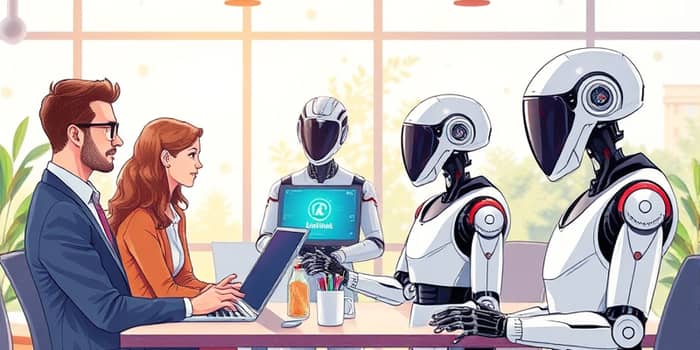
In 2025, artificial intelligence is no longer a distant promise—it is embedded in the fabric of businesses across every sector. Enterprises are racing to deploy AI tools that automate workflows, enhance decision-making, and unlock new revenue streams.
Yet as AI adoption accelerates, policy frameworks and workforce support systems are struggling to keep pace, creating gaps that threaten equity, productivity, and long-term prosperity.
Data from Q1 2025 reveals that AI-related job growth in the U.S. soared by 25.2% compared to the same period in 2024. A total of 35,445 AI-focused positions were recorded, with AI and Machine Learning Engineer roles growing fastest at 41.8% year-over-year.
Advanced industries such as financial services and technology report adoption rates exceeding 85%, while manufacturing and retail lag closer to 50%, exposing an adoption divide that shapes the competitive landscape.
Even compensation reflects AI’s strategic value: the median salary for AI roles in Q1 2025 was $156,998, underscoring the premium placed on advanced digital skills. However, over 75% of leaders and managers use generative AI regularly, but only 51% of frontline staff do so, highlighting a growing digital chasm where frontline employees are left behind.
As organizations embrace AI, the worker experience is marked by both promise and apprehension. By 2030, forecasts estimate up to 92 million roles displaced globally, offset by 170 million new positions—yielding a projected net gain of 78 million jobs.
Yet distribution is uneven. In advanced economies, 60% of existing roles face automation risk, compared to 26% in lower-income regions. Workers without a high-school diploma are least threatened by automation, while young employees aged 18–24 report 129% higher anxiety about obsolescence.
Productivity metrics tell a powerful story: companies report a 66% increase in daily task throughput when integrating AI tools—an acceleration equivalent to nearly five decades of natural progress. At the same time, nearly two-thirds of professionals say they feel overwhelmed by the pace of change, caught between newfound efficiencies and job security concerns.
Despite overwhelming consensus that AI-driven change is inevitable—70% of business leaders acknowledge the rapid transformation—support structures remain inadequate. Only one-third of employees report receiving sufficient AI training, and just a quarter feel they have strong leadership backing.
This gap underscores the critical need for strategic upskilling and the modernization of workplace governance. Experts warn that without robust, inclusive learning pathways and updated regulations, the benefits of AI will concentrate among the already advantaged.
Calls for action emphasize investment in computing infrastructure, broadband access, and responsible AI development and deployment, ensuring privacy preservation, bias mitigation, and transparency are built into every solution.
Companies that align technology adoption with human capital development will set the pace. Consider these organizational strategies:
Embedding learning in daily workflows transforms AI from an external threat into an internal ally, empowering employees to innovate alongside machines.
With legislative responses lagging behind technological breakthroughs, stakeholders must unite around pragmatic, evidence-based workforce policies that adapt as AI evolves:
Such measures will help ensure that workforce interventions are data-driven and targeted to the communities most affected by automation and digital transformation.
Workers can take proactive steps to reinforce their career resilience. By embracing lifelong learning and advocacy, individuals can shape how AI integrates into their roles:
These efforts help enable a future of shared prosperity, positioning professionals as indispensable contributors in any tech-enhanced environment.
The convergence of AI and the workforce presents both tremendous opportunity and profound responsibility. By embedding surging ahead of policy frameworks into a strategic vision, businesses and governments can modernize training, regulations, and infrastructure together.
Bridging the gap between cutting-edge technology and workforce policy is not merely an administrative task—it is a moral and economic imperative. By committing to evidence-based workforce policies, prioritizing responsible AI development and deployment, and fostering a culture of continuous learning, we can transform disruption into opportunity and enable a future of shared prosperity for businesses, workers, and society at large.
References













